Abstract
For collectible card play online games (CCGs), play online games designers often limit the availability of cards that have a particularly powerful play online games effect. The conventional wisdom is that the more powerful a card is, the more rare it should be. The long-term implications of such an approach can have negative consequences on a play online games suitability for casual play. Digital Addiction (a company that produced online, collectible cardplay online games in the 1990s) developed a different play online games design philosophy for balancing collectible card play online games. The approach called for the most obviously and generally useful cards to be the most common and to equate rarity to specialization rather than raw power.Keywords: Game design, collectible card play online games, CCG, play online games balance, Sanctum, Magic: The Gathering
Introduction
This paper explores the complex play online games balancing issues inherent to collectible card play online games. It begins with an overview of the Magic: The Gathering card play online games and follows with comparative case studies of Sanctum and Trading Card Baseball, both of which were online collectible “card” play online games. Sanctum’s play online games designers, after experiencing early balancing problems, developed a play online games design philosophy that attempts to address the issue every collectible card play online games faces: the fact thatplay online games advantage can be purchased. When Sanctum’s play online games designers later created Trading Card Baseball, they attempted to address this issue holistically by taking advantage of baseball’s statistical nature.Fun & Balanced
"Games are fun" is aplay online games design truism (Caillois, 1957) [i]. When a play online games involves only a single player, providing “fun” can be the overriding design concern. If the player is given a sense of incremental advancement against reasonably challenging obstacles, then the play online games will probably be enjoyable.Multiplayer play online games are trickier. At a certain point, one player will be advancing towards victory and the other(s) towards defeat. Losing is not fun. The mild consolation usually given to losing players is a sense of fairness. While the winner may have been lucky (if the play online games has an element of chance), the rules did not inherently and arbitrarily favor one player over another (Salen & Zimmerman, 2004). In order to ensure fairness, a large portion of the play online games design process is spent play testing and “balancing” the rules. Balancing is an evocative term - it not only brings to mind the scales of justice but also a precarious state in which one poor choice can tumble a tower of Jenga pieces (Scott, 1983).
A common play online games balance dilemma arises when the player moving first has an advantage. Such an imbalance can be corrected by giving the first move to the weaker player as a handicap, as is common in Chess (anon., circa 1475) having the end result adjusted, as with the komi points given to the second player in Go (anon., circa 1000 B.C.E.); or when all else fails, using a cumulative score of two play online games so that each player has the opportunity to play a first move - an approach that is commonly used by balance-minded players of Cathedral (Moore, 1979) and Othello (Hasegawa, 1971).
Unfair
With all the effort that goes into making play online games fair, it may be surprising that collectible card play online games (CCGs), such as Magic: The Gathering (Garfield, 1993), are unfair by design. In a CCG, each card has some effect on the play online games: increasing the player’s resources, decreasing an opponent’s resources, changing a rule, and so forth. The individual cards’ level of impact varies. Some cards have a minor, incremental effect; others cause dramatic, play online games changing transformations to the play online games state or rules.Collectible card play online games are not available in complete sets. Instead, subsets of the play online games’ cards are sold piecemeal in the form of semi-random packs of cards. The distribution is regulated so that some cards are much more scarce than others. In order to obtain a complete set, a player would need to purchase many packs of cards, trade with other players for rare cards, and/ or purchase individual cards on the secondary market.
Players with larger collections of cards have a greater range of options and therefore an advantage. If Chess’s play online games were structured like a collectible play online games, one player might begin the play online games with several queens while the opponent is only able to field a set of pawns and knights.
Suitcase Players
The fact that play online games advantage can be purchased is not lost on CCG players. Players with large collections of cards are semi-disparagingly referred to as suitcase players [ii]. “Suitcase” carries the dual implication that the player spent a suitcase worth of money in order to purchase a collection of cards that needs a suitcase to transport.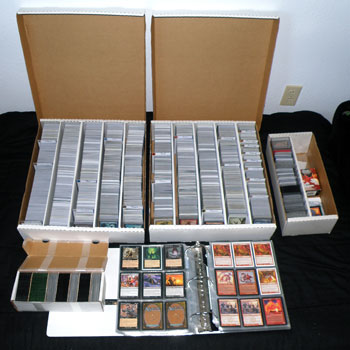
Figure 1. Suitcase player’s collection
(Source: Cody Durkin, www.mastermarf.com, Creative Commons Attribution-Noncommercial-Share-Alike 3.0 license)
One approach for eliminating the advantages of large collections is through “sealed-pack” play online games in which each player plays with cards that came from a certain number of previously unopened packs. Suitcase play (as well as the compensating sealed-deck play) encourages continuing sales of the play online games, which presents a financial temptation for play online games developers to reinforce suitcase style play. Doing so, however, risks alienating casual players. This message board comment demonstrates the frustration of such a player:
- My buddy had a job in highschool and I didn't (3 sports), and he spent all of his paycheck on that damn
- . After awhile he ruined the fun, a casual player can't compete with a suitcase player. That's what makes Magic kinda ghey. (Akronn, 2003)
It is worth noting that the homophobic derogation is directed at Magic: The Gathering specifically and not at collectible card play online games in general. Because of its continuing commercial success, over 10,000 different Magic cards have been released (Wizards of the Coast, 2009). The immense variety of cards gives an almost exponential advantage to players with large collections. Exacerbating this is a strong correlation between the most rare and the most powerful cards. A player might need to purchase and sift through a suitcase of cards in order to find a few play online games dominating cards, in the same way that a mining company might need to blast and sift through a mountain in order to find a few nuggets of gold.
Expansion sets can also drive suitcase style play. Most collectible card play online games do not have a static play online games design. Instead, expansion sets of cards are periodically released. Magic: The Gathering, for example, adds about 500 new cards a year (Wizards of the Coast, 2009). The added sets can drive sales (by having more cards to collect), renew player interest (through novel play online games), and correct play online gamesplay imbalances (by creating cards that undermine a particularly effective strategy).
There is a natural tendency for play online games developers to design new cards that do not offer more play online games, but more powerful play online games. Doing so ensures that the new set of cards will be relevant to the play online games, perhaps even required by players who wish to remain viably competitive. This can result in an arms race of collecting in which each successive set trumps the previous one in terms of play online games power.
Defining an Online Collectible Object Game
Digital Addiction, a software play online games company the author co-founded, developed two online collectible object play online games in the late 1990s [iii]. An online collectible object play online games is a computer based play online games in which players own virtual objects that have an effect on play online games, persist between play online games sessions and are not equally available to all players.This characterization of collectible objects would encompass most massively multiplayer play online games (MMPG) and even the average single-player adventure play online games. However, online collectible play online games is more fully focused on the collectible objects than is typical in MMPG and adventure play online games. In an MMPG, the various objects that a player collects may have important play online gamesconsequences, but they generally take a secondary role and are viewed as adding incrementally to a player character’s basic traits. In contrast, a collectible play online games core play online games is in the collectible objects and has little, if any, sense of an avataristic in-play online games character.
Examples of online collectible object play online games include Chron-X (Genetic Anomalies, 1997), Sanctum (Digital Addiction, 1997), Magic: The Gathering Online (Leaping Lizard Software, 2002), and Star Chamber (Nayantara Studios, 2003).
Digital Addiction’s Sanctum was consciously patterned on Magic: The Gathering. As with Magic, Sanctum’s collectible objects are spells that are represented using a card metaphor and put into play by spending magical energy resources (mana). In contrast to Magic: The Gathering and Magic: The Gathering Online’s play online games, which exists solely in the play online games cards, Sanctum is played upon a two-dimensional field of terrain and towns (Figure 2).
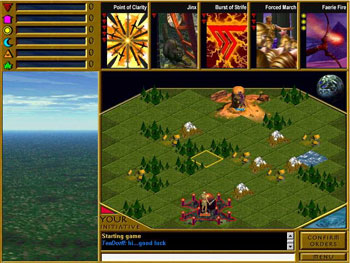
Figure 2: Sanctum play online games board
(Source: NIOGA, used with permission)
Sanctum’s use of a card metaphor may seem an odd vestige to carry over from physical collectible card play online games. On a computer screen, cards become a virtual abstraction of a cardboard abstraction of magic. A more thematic screen representation of spells might have been scrolls, but Sanctum retained the metaphor of cards due to its familiarity to CCG players. When a Sanctum spell is put into play, however, the card metaphor is abandoned for a more literal representation of the spell’s effect: a monster appears on the terrain, an element on board begins to glow with enchantment, a town is created, and so forth.
Early Errors in Rarity & Balance
Sanctum was released in 1997 with an initial set of 223 cards [iv]. Included in the initial set were cards entitled Apocalypse, Bleak Isle, and Sword of Zana. These three cards quickly became a problem; they were too powerful and unbalanced the play online games.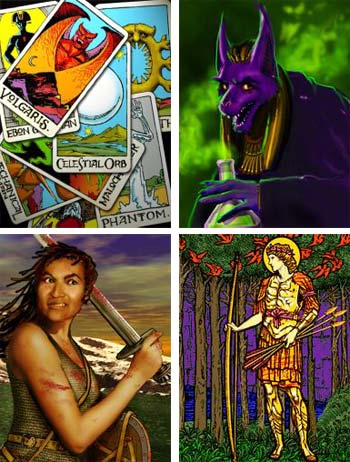
Figure 3: Sanctum card art
(Source: Lee Moyer, www.leemoyer.com. Used with permission)
Early in 1994, the developers of Magic: The Gathering had faced a similar situation when they realized that nine of their cards, which eventually became known as the “Power Nine” (Daily MTG, 2003), were unbalancing the play online games. Collectible card play online games are by nature rule exception play online games (Costikyan, 1998) in which the cards alter and add to a core set of rules. Balancing such play online games is extremely difficult because not only does the basic set of rules need to be tested and balanced, but all the permutations of card effect combinations should be considered as well. There is a good chance that a CCG’s player community will find a play online games killing strategy, especially when the play online gamesis new and its designers may not have fully grasped the play online games peculiarities.
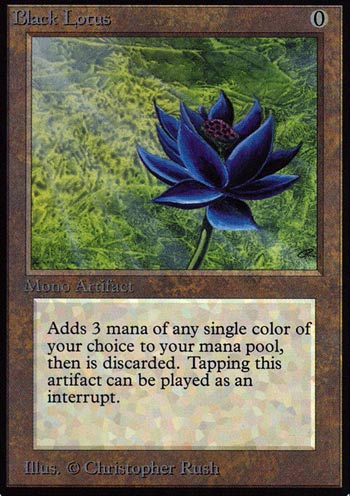
Figure 4: Black Lotus, one of the Power Nine.
(Source: Wizards of the Coast, used with permission.)
The Power Nine were released in Magic: The Gathering’s first set (Limited Edition Alpha) in August 1993 and went out of print with the release of the Revised Edition expansion set in April 1994 (Ashley, 2008). After the cards were discontinued, their prices skyrocketed. As of 2 October 2009, the two most recent Black Lotus eBay auctions ended with the card selling at US$1924.99 and US$1980.66 (eBay, 2009).
Sanctum’s Out-of-Print Cards
Sanctum’s Apocalypse, Bleak Isle, and Sword of Zana cards are particularly powerful as defensive cards. A player facing defeat can use them and stop the opponent’s offensive drive. Jamey Harvey, who was Digital Addiction’s CEO, recalls:- The problem was that these cards in particular were annoying because they were late
- cards (expensive [to play in terms of
- resources]) and if you were already winning didn't speed you up, but if you were losing would slow the
- down without changing the fundamental dynamics.
So somebody with four Bleak Isles or four Swords of Zana could take a
- which was winding down unfavorably and instead of lasting 30 minutes make it last a frustrating, annoying, grating three hours... and they would still lose but now you had two unhappy, annoyed players. (Harvey, 2009).
This echoes what would become Digital Addiction’s official stance. The cards’ potential to drag out play online games was a real concern, though their uselessness to turn the tide of a play online games is a bit overstated (perhaps as an attempt to console players whose collections do not include these cards).
Digital Addiction’s staff discussed at length two possible solutions for the addressing the issue:
- 1. The problem cards’
- design could be adjusted to be more balanced; or
2. The cards’
- could be left as is, but the company could discontinue distributing the cards in order to minimize the chance that a player would experience the unbalancing effect.
Both solutions had risks. Discontinuing the cards might simply perpetuate a play online games imbalance and institute suitcase style play. On the other hand, Digital Addiction was unsure how players would react to having their purchased cards suddenly change - it would be as if a Magic: The Gathering developer broke into players’ houses to update their cards with a Sharpie marker. Digital Addiction imagined an enormous outcry from the players if their collections were retroactively changed.
Digital Addiction decided to discontinue the cards, but leave alone the play online games design of the copies already in existence.
In some ways, this was as much a business decision as one based on play online games design or player community considerations. Digital Addiction was finding that the press and potential investors were often dubious that virtual objects could have value as collectibles. The thinking seemed to be that the collectability of Magic cards, for example, was inherently tied to the cards’ physicality. By ending the distribution of the play online gamescards, Digital Addiction thought it would not only solve a balance issue, but it would also prove Sanctum’s collectibility. Discontinuing the cards would ensure that the few that had been introduced to players’ collections would be extremely rare and, it was hoped, valuable in a secondary market. So the cards were discontinued and the “out-of-print” (OOP) cards began being sold on eBay for around $100 each.
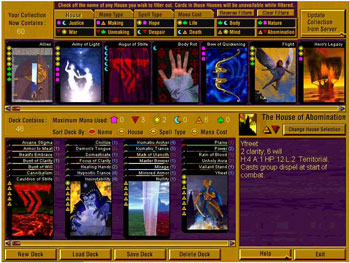
Figure 5: Sanctum's deckbuilder
(Source: NIOGA, used with permission)
The decision to make the cards out-of-print seemed the more conservative choice: Digital Addiction was following the precedence set by Magic: The Gathering’s developers. However, following Magic’s model did not prove to be as safe as Digital Addiction had hoped. There was a widespread and angry reaction from the player community. Players abandoned the play online games over the issue and the controversy was still quite alive up until the point that Digital Addiction closed its doors three years later [v]. Digital Addiction felt trapped by the decision because once players were paying to purchase the out of print cards on the secondary market, the company did not want to sandbag them by reversing its decision and undermining the cards’ inflated values [vi].
Wizards of the Coast (the publisher of Magic: The Gathering) feel similarly trapped by its secondary market. In July 2002, Wizards of the Coast published an “Official Reprint Policy” which presented a list of cards (growing to 572 cards by October 2009) that would never be reprinted. The statement that accompanied the list explained, in part:
- Primary to the value of purchasing Magic cards is the concept that each card will maintain a reasonable value over time. Because we're sensitive to this issue and to the ramifications of reprinting cards too soon or too often, we try to make decisions that won't negatively affect card collectability over time and that will enhance the value of cards you purchase.
To maintain your confidence in the Magic
- as a collectible, we've created this Magic: The Gathering card reprint policy. It explains why we reprint cards and lists which cards from past Magic sets will never be reprinted. (Wizards of the Coast, 2002)
As was the case with Sanctum, the play online games designers came to view the decision as a mistake. Mark Rosewater, who is currently Magic: The Gathering’s head play online games designer, explains:
- You see, many years ago, Wizards released Chronicles and Fourth Edition. In it were cards from some of the recently released sets that had sold out in hours. As such, cards from these sets had high secondary market values, many of which plummeted when they got reprinted. This upset many of the collectors, as they feared that the value of their collection might evaporate overnight. To stem these fears, the then Magic Brand Team came up with a list of cards that Wizards promised they would never reprint... The Reserved List has become somewhat of an albatross around R&D's neck. (Rosewater, 2006)
Sanctum’s “reserved list” of out of print cards stopped after the first three. Eventually Digital Addiction learned that it could routinely adjust the cards’ play online games without causing much controversy. Still, the concern had merit as later shown in July 2009 by the anger that erupted in response to Amazon deleting from its customers’ Kindle electronic book devices an inadvertently unlicensed edition of George Orwell’s 1984 (and refunding the purchase cost).
A Philosophy Emerges
The conventional wisdom is that the more powerful a collectible card is, the more rare it should be. As described in Wikipedia (cited here to give the common understanding of the topic) there is a direct relation between power and rarity:- ... in CCGs, the level of rarity also denotes the significance of a card’s effect in the
- , i.e., in general the more powerful a card is in terms of the
- , the greater its rarity. A powerful card whose effects were underestimated by the
- ’s designers may increase in rarity due to those effects; in later editions of the
- , such a card’s level of rarity might increase to reduce its availability to players. Such a card might even be removed entirely from the next edition, to further limit its availability and its effect on
- (Wikipedia, 2009)
Based on this idea, the policies of discontinuing overpowered cards in Sanctum and Magic: The Gathering made sense. However, using rarity to try to balance a powerful card actually worsens the problem. There are usually defenses against play online games unbalancing cards [vii], but having to resort to elaborate countermeasures does not really help. Players worried about a particular overpowered card have the dubious choice of employing a defensive strategy that is useless in most cases (and dilutes their ability to play effectively against more common threats), or being vulnerable to an unlikely, but devastating, attack. Having to use a situation-specific defensive card (just in case), is as appealing as having to carrying around a fire extinguisher (just in case).
Because of the extreme negative reaction to its decision to discontinue several cards, Digital Addiction began to question the “power equals rarity” approach to play online games design and balance. By the time Sanctum’s second expansion set (Oppositions) was being designed, Digital Addiction was employing a new play online games design philosophy. As expressed by Lee Moyer (the artist for all of Sanctum’s cards and the producer for Oppositions) rarity should equate to specialization, not power. In fact, the more bluntly powerful the card is, the more common it should be.
Moyer explained this idea using an analogy of tools. The most common tools are, in a way, the most powerful ones. A toolbox that contains a screwdriver, a hammer, pliers, tape measure, a drill, and a circular saw cannot be beat in terms of sheer usefulness. In most cases, an exotic tool, a hammer drill for example, would not do as good a job as the more common tools. However, in the rare cases where a hammer drill would be useful, it makes the job much easier, quicker, and cleaner. Such is the approach Digital Addiction took with its expansion cards. The more obvious/ powerful the usefulness of a card, the more common the play online games’s designers made it. The more oddball/ specialized the card, the more rare it was made.
Simply stated, if a card is so powerful that it would unbalance the play online games if everyone had a copy or two of the card, then the card is inherently broken. Digital Addiction did not want to design cards that are hard to obtain, but once owned gave straightforward and easy wins.
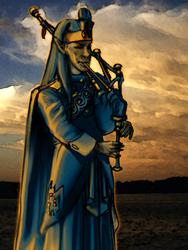
Figure 6: Elven Piper
(Source: Lee Moyer, www.leemoyer.com. Used with permission)
One of the inspirations for this philosophy may have been the beta-test reward cards that were given out to players who helped test Sanctum and its expansions. As a “thank you,” the company gave each tester a limited edition card. These cards were designed to be purely commemorative - to have no impact on play online games. Digital Addiction did not want players who later joined the play online games to feel resentful that they missed out on a card that gives its owners some advantage. Also, a powerless card seemed both more special and more in the spirit of the testers’ volunteerism. The only effect of Elven Piper (Figure 6), which was the reward card for the initial release’s beta-test, was to play bagpipe music during certain combat events in the play online games.
Despite having essentially no effect on play online games, the beta-test cards were highly prized (and sold on eBay for prices rivaling the out-of-print cards) [viii]. The combination of the cards rarity, powerlessness, and popularity was an interesting lesson for Digital Addiction’s play online games designers.
Trading Card Baseball
Digital Addiction’s play online games design philosophy was refined over the course of creating 380 cards - the sum of the original release of Sanctum followed by two expansion sets. In 1999, Digital Addiction had the opportunity to apply the lessons it learned to the development of Trading Card Baseball, its second collectible object play online games [ix].Trading Card Baseball was targeted towards casual play online games. The play online games players collected Major League Baseball ballplayers (using the obvious metaphor of baseball cards) with which they fielded a ball team. Trading Card Baseball’s play online games action was designed to be less involved than the finger twitch action of controlling every pitch and swing, yet more involved than the hands off style play of fantasy leagues in which the play online games’ decisions are limited to roster changes.

Figure 7: Trading Card Baseball’s modeless strategy dialog boxes
Trading Card Baseball put the play online games’s players in the position of a team manager who gives general directions to the ballplayers, but does not directly control their actions (Figure 7). The decision-making could be put on “autoplay” so that the computer makes default choices. In addition to these strategic decisions, play online games players could also play action cards (that are associated with the ballplayers’ cards) that caused events such as “Next swing is an automatic hit.”
Suitcase style CCG play is viewed with annoyance when it seems that the quality/ quantity of a player’s collection overrules the quality of an opponent’s in-play online games choices. Yet most players want their collections to be meaningful and like the idea that skill in putting it together - which may involve savvy trading as much as spending money - has impact on their ability to play a competitive play online games. These two conflicting desires (money not dominating the play online games, but building a good collection results in some play online games advantage) create a dilemma for the designers of almost every collectible card play online games Trading Card Baseball, however, provided a chance to create a play online games that resolves the quandary.
Baseball is an extremely statistical play online games. Everything is boiled down to a numerical value, such as a pitcher’s WHIP statistic representing Walks plus Hits divided by Innings Pitched. Trading Card Baseball’s play online games was largely based on the ballplayers’ statistics as modified by the play online games player’s strategy orders and action card playing [x].
Because the cards’ play online games effects are statistically driven, it was possible to make objective analyses of the play online games power of each card. Based on the ballplayers’ statistics, each card was given a “heat” rating of Smokin’, Hot, Warm, or Cool that represents how skilled the ballplayer is at the play online games [xi]. Likewise, the teams that are cobbled together from the cards are rated by using the average “heat” designation of the teams’ players.
The implications of the heat rating system are interesting. Trading Card Baseball’s matchmaking system exposed the heat of the teams, so a person with a weak team could choose whether or not to play against someone who is fielding a more powerful team. Also, the rankings of the play online games players could be broken out into recognizing the top teams in each heat category (as well as being able to list top underdog players - players who win even when they are playing an outmatched team). So having a great “Cool” team could gain as much recognition as having a great “Smokin’” team.
Certainly a player with a large collection would have had more choices and probably could have fielded a better “Cool” team than a player with a small collection. However, that is the sort of advantage that is desirable in a collectible card play online games: the player with the better collection has an edge, but not to the extent that is disheartening for the casual player.
Conclusion
This paper explored issues of balance in play online games that use collectible objects. It focused on case studies of play online games that use a card metaphor, but collectible object play online games can be more broadly defined. The category can be seen as including any play online games in which the players are able to use obtainable, but limited, resources to dynamically alter the rules (or at least the rules’ effects and applications).The play online games design conventional wisdom for collectible object play online games is to have the most powerful effects be the least likely to be brought into play. The powerful objects are usually limited by reducing the number available to the player population or by increasing the resource expense of putting the object into play. Of the two approaches, the former is more problematic because it has the potential to create a playing field that is so unlevel that the game is not fun.
Digital Addiction’s initial release of Sanctum was largely balanced using the common methods of making powerful cards rare and costly. When designing Sanctum’s first expansion set, however, this approach was reconsidered. The play online games designers decided that the most easily applied power - the play online games effects that most directly and efficiently carried a player toward victory - should be the common. Instead of conveying raw power and obvious application, rare and expensive objects were designed to have specialized effect. By being specialized, the rare cards are useful in limited situations and require expertise when putting them into play. But in the right situation, these rare cards can have dramatic effects on play online games.
Having a stated approach to play online games design requires a certain amount of balance within itself. Creating a rich play online games experience calls for avoiding formulaic constructions. However, collectible object play online games need particular design care because the play online games assets persist, become owned by players, and essentially take on a life of their own. There is a risk that play online games advantage may be hard to obtain (either because of the expense of time or money), but once achieved the advantage is easily maintained and put into play. When this is the case, the play online games will discourage both casual and novice players.
Some designers attempt to resolve this problem by continually introducing progressively more powerful objects. This allows new players to be competitive with more established players. However, this also often leads to dissatisfaction amongst a play online games’s long-term and most dedicated players.
Addressing these issues is the goal of disassociating power and rareness. Done well, it can lead to play online games environments that both casual and serious players find enjoyable and appropriately challenging.
References
Akronn. (2003). Pseudonymous discussion board post. Retrieved on 9/25/2009 from Realpoor. Website: www.realpoor.com/magic_2003_world_championships_live_webcast_tref165141Ashley, M. (2008). “Ask Wizards.” Retrieved 2 October 2009 from Wizards of the Coast. Website: www.wizards.com/Magic/Magazine/Article.aspx?x=mtg/daily/askwizards/0808
Caillois, R. (1957). Les jeux et les hommes. Paris: Gallimard.
Costikyan, G. (1998). Don’t Be a Vidiot. Speech given at the 1998 Computer Game Developers Conference. Online at play online games
Daily MTG. (2003). “The Power Nine.” Retrieved 9 October 2009 from Wizards of the Coast. Website: play online games
Dennen, P. (2003). Star Chamber. Nayantara Studios,
Digital Addiction development team. (1997). Sanctum. Digital Addiction.
Digital Addiction development team. (unreleased). Trading Card Baseball. Digital Addiction.
EBay. (2009). Completed auction results. Retreived 2 October 2009 from eBay. Website: play online games
Garfield, R. (1993). Magic: The Gathering. Wizards of the Coast.
Leaping Lizard Software. (2002). Magic: The Gathering Online. Wizards of the Coast.
Moromisato, G. (1997). Chron-X. Genetic Anomalies.
Harvey, J. (2009). Personal communication.
Hasegawa, G. (1971). Othello. Tsukuda Original Company.
Moore, R. (1979). Cathedral. Chrisbo I.P. Holdings Limited.
Rosewater, M. (2006). “Life Lessons, Part II.” Retrieved 5 October 2006 from Wizards of the Coast. Website:play online games
Salen, K. & Zimmerman, E. (2004). Rules of play: play online games design fundamentals. Cambridge: MIT Press.
Scott, L. (1983). Jenga. Leslie Scott Associates.
Wikipedia. (2009). “Collectible Card Game.” Retrieved 3 October 2009 from play online games
Wizards of the Coast. (2009). “Magic: The Gathering Fact Sheet.” Online at play online games
Wizards of the Coast. (2002). “Official Reprint Policy.” Online at play online games
End Notes
[i] “Games are fun” may be a truism, but not a universally accepted one. Game designer Marc LeBlanc views the term “fun” as a lazy synonym for a more complex, but less understood, experience (Salen & Zimmerman, 2004).[ii] An example of the term being used is play online games designer Paul Peterson’s “Excuse me, Mr. Suitcase?” column in The Duelist, a CCG focused magazine that was published by Wizards of the Coast during the second half of the 1990s.
[iii] Digital Addiction was the brainchild of Jamey Harvey. His fellow co-founders included Ethan Ham, Benjamin Rosenbaum, Lee Moyer, and John Mueller.
[iv] In 1997 Sanctum was released in the form of a public beta-test. In 1998, the beta-test players’ accounts were erased and the play online games was re-released as a commercial product.
[v] When it closed, Digital Addiction did not want Sanctum to shut down, so it turned the play online games over to NIOGA (www.nioga.net), a non-profit organization formed by a group of the play online games’s players. NIOGA eventually converted to a for-profit venture and has continued to support and extend Sanctum.
[vi] Magic: The Gathering has rules limiting what sort of tournaments the Power Nine can be used in. Digital Addiction probably should have done something similar and ban the out-of-print cards from being used in ranked play online games (games whose outcome have a lasting impact on the players’ win/loss statistics).
[vii] It is common for collectible card play online games designers to take advantage of an expansion set to introduce a card that counter-effects an overly powerful card from the previous expansion.
[viii] Sanctum players who enjoyed being analytical often pointed out that the beta-test cards are not completely without effect. A number of cards in the play online games have an effect that is altered by other spells (e.g., +1 strength for each spell that has been cast upon the unit). So it is possible that playing an Elven Piper would result, for example, in a unit gaining strength.
[ix] Sadly, though the play online games development was completed, it was never released. The core play online gamesdesign team on Trading Card Baseball was Paul Dennen, Ethan Ham, and Tony Van - though the entire Digital Addiction team contributed.
[x] One interesting aspect of Trading Card Baseball’s design was that each week during the baseball season, the cards would be updated to reflect the ballplayers’ current statistics. This made the play online games value of the cards dynamic - an obscure or previously weak ballplayer might suddenly become a star, or a great ballplayer might underperform.
No comments:
Post a Comment